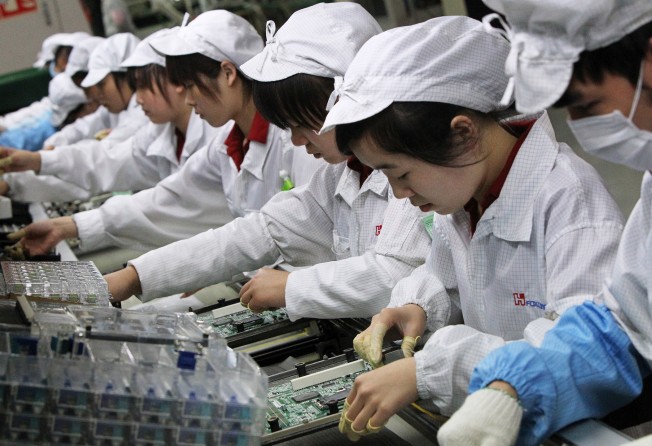It will be some time before robots will replace Foxconn's workers
Manufacturer's factories still primarily staffed by workers despite growing use of robots

Several years ago, amid rising labour unrest at factories on the mainland, Foxconn Technology chairman and founder Terry Gou Tai-ming announced his company planned to have a million robots installed at its plants within three years.
Where is this phalanx of robots today?
Foxconn had already installed hundreds of thousands of robots to replace human workers and was swiftly moving towards its goal of a million, Erik Brynjolfsson and Andrew McAfee reported in their book, The Second Machine Age, published in January.
Yet the manufacturing giant, which counts Apple among its chief customers, remains quite secretive about its production and use of robots. And analysts who cover the company say it actually trails its competitors in automation.
Moreover, if hundreds of thousands of iPhone assembly line workers were being replaced by robots, one would have thought this might have caught the media's attention. When several Foxconn workers committed suicide four years ago, the story became front-page news across the globe.
Recall that this is the same Gou who, when giving a speech at a Taiwanese zoo, complained that like the zoo keepers, he also had to "handle a million animals" - referring to Foxconn's workforce - and it gave him a lot of "headaches".
Imagine the relief if technology could save him from the messy business of trying to figure out just what workers will demand next. Counselling, better dormitories, pools and recreation facilities, shorter hours and explosive wage rises: Foxconn has had to meet these and other demands in the past several years.
In fact, as much as Foxconn might like to replace its workforce with robots in a few short years, neither the maths nor the politics of a rapid transformation add up.
Even in manufacturing sectors, such as carmaking, where robots have replaced workers in developed countries, we are not seeing wholescale refittings of factories with robots on the mainland.
These things take time and face resistance at a political level because the mainland is still a state-planned economy that has to balance between increasing productivity and providing jobs.
The idea that countless workers on the mainland are about to lose their jobs to robots - just as workers in the West were once replaced by Chinese - is more myth than reality.
Alberto Moel, who follows electronics technology trends at Bernstein Research, has long been sceptical that Foxconn would be able to radically automate its workforce in a few short years.
For companies with the kind of manufacturing and assembly requirements that Foxconn specialised in, "replacing humans with robots is a daft idea in the mid-term", he said.
Nor do Foxconn's financials indicate such a transformation is taking place. Even with advances that have made robots more flexible and much cheaper, the upfront cost of replacing hundreds of thousands of low-end assembly line workers with robots would show up in the form of a major one-off increase in capital spending as a percentage of overall costs. Yet no such expansion is evident in Foxconn's capital expenditure trends.
What we are seeing instead is that Foxconn is turning to automation to increase efficiency and "hold the line" on wage increases through manufacturing efficiency improvements.
Thus, although Foxconn's wage rates increased a stunning 70 per cent between 2009 and 2012, gross profit per employee fell by only 26 per cent, Moel said.
Automation helped keep offset those rising costs; but so did Foxconn's move to inland China, where land and labour prices are less inflated.
Now consider this: on the one hand, we have one of the biggest and most broadly owned manufacturing companies, Foxconn, whose financials are constantly examined by big investment banks and global fund managers.
They are intricately aware of Foxconn's production and cost trends. They know those massive worker dormitories are not emptied and that hundreds of thousands of robots are not doing what pesky workers used to do.
On the other hand, we have the world's top economic blogs, think tanks, commentators and academics earnestly discussing the fact that automation technology has developed to the point where even the mainland is rapidly replacing workers with robots.
But as anyone who owns Foxconn shares or covers the company knows, this is rubbish. It is also an indicator that there may be some hype attached to the new robot mania.
There is no doubt that the mainland is increasingly investing in automation and this has slowed the pace of hiring in manufacturing that we would otherwise be seeing in light of the country's huge output.
But for now, its massive network of factories is still primarily staffed by blood-and-flesh workers, and it will take those who manage these "animals" more than three years to change this.